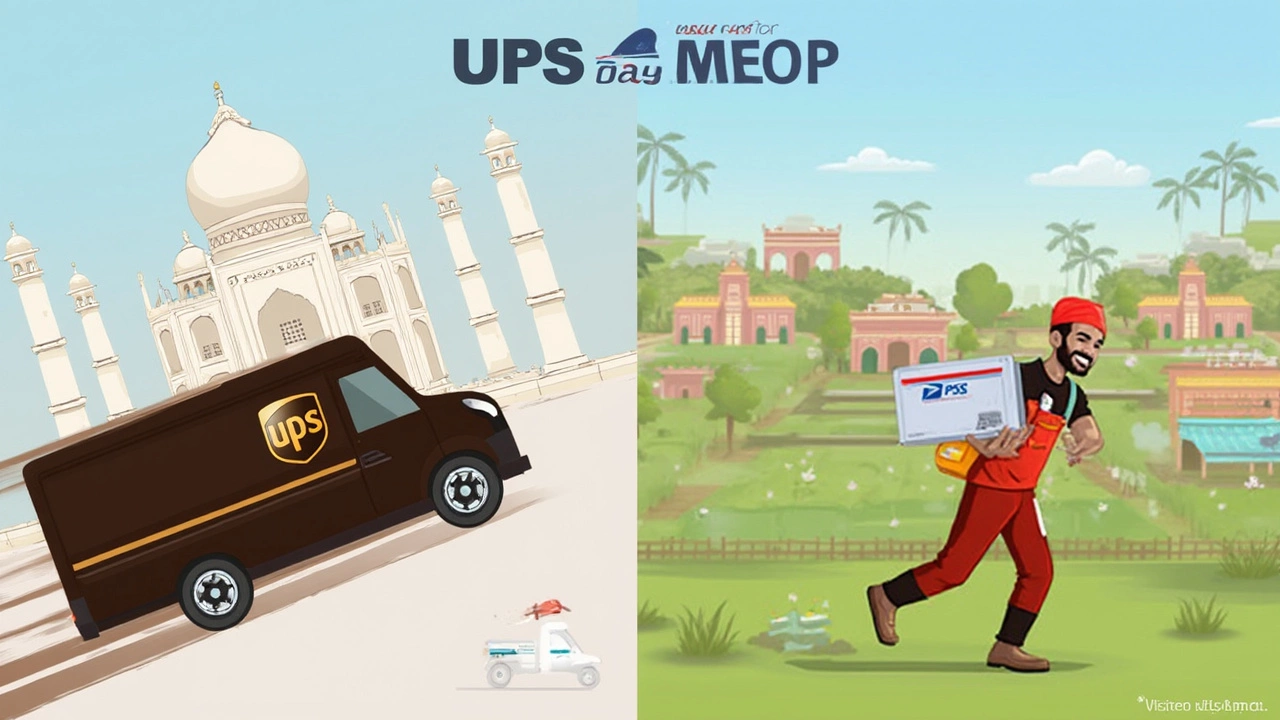Shipping a 10 lb package internationally? You've got some options, and choosing wisely can save you a fair bit of cash. The big players in the game, UPS and USPS, offer different rates, delivery times, and fee structures. So what's the real cost difference? Let's break it down.
First off, you'll likely notice that USPS generally rings in with lower base rates. But it’s not always that straightforward. UPS often includes robust tracking systems as part of its service, which might be a dealbreaker if your overseas shipment is something you can't afford to lose.
Keep in mind that these services also differ when it comes to delivery speed. USPS might take a bit longer but it also might surprise you with their regular and priority options that come cheaper but slower. Meanwhile, UPS might get your package there faster—at a price.
- Introduction to Shipping Options
- Cost Comparison
- Delivery Time and Reliability
- Hidden Fees and Considerations
- Tips for Cost-effective Shipping
Introduction to Shipping Options
When it comes to international shipping of a 10 lb package, your go-to options are usually UPS and USPS. Both are reputable, but they cater to different needs. Understanding what each offers is key to making the right choice for your specific situation.
UPS is known for its reliability and speed. They pride themselves on having a global network that's capable of delivering almost anywhere. Plus, their tracking system is top-notch, giving you peace of mind because you can see exactly where your package is at almost any given time. As the UPS website puts it,
"From packages to pallets, we've got the speed and reliability to meet your needs."
On the flip side, USPS is often the budget-friendly pick. Their rates for smaller packages, specifically those under 13 oz, can be very attractive. But even a 10 lb package could cost less with USPS if your delivery isn't time-sensitive. Their Priority Mail International service, though slower, comes with free package pick-up and delivery confirmation.
Choosing Based on Needs
So, how do you decide?
- For quick delivery and top-tier tracking, UPS might be your best bet.
- If you're more about saving pennies, USPS could be the way to go, especially for non-urgent items.
Still, don't forget to factor in the additional costs like insurance and handling fees, which can catch you off guard if you're not careful. Remember, even tiny fees add up. Understanding these costs can help you stay within budget without surprises.
Cost Comparison
When you're shipping a 10 lb package internationally, it's crucial to know your numbers. Right out of the gate, USPS often starts with a lower price point. For example, shipping via USPS Priority Mail International can set you back around $60 to $70, depending on the destination. But remember, prices fluctuate based on several factors, including shipping zones and specific country tariffs.
On the other hand, UPS is known for its reliable service and tracking capabilities. A similar 10 lb package using UPS Worldwide Expedited can range from $100 to $130. This might seem steep, but the speedier delivery and comprehensive tracking might justify the higher price for some users.
Breaking Down the Fees
It's not just about the sticker price. Both UPS and USPS may have hidden costs like surcharges for fuel, remote area delivery, or special handling. For instance, UPS might charge extra if your package requires additional handling or travels through less accessible regions. On the flip side, USPS might include costs in the upfront shipping rate, making it slightly higher than advertised.
According to a report from the International Postal Corporation, "Shipping costs for packages increased by an average of 5% annually, influenced by fuel price changes and global logistics challenges."
Comparing by Delivery Time
Delivery speed is another layer to consider. USPS generally offers slower delivery options to maintain lower prices. Expect Priority Mail International to take anywhere between 6 to 10 business days. If that's too long, UPS can often get it there quicker, sometimes in 2-5 days, though, of course, you're paying for that haste.
Is There an Average Cost Difference?
From a bird's eye view, shipping with USPS will likely save you 20-30% compared to UPS on average for a 10 lb package. However, if speed and tracking are crucial, the price difference might be a trade-off worth making.
| Service | Expected Cost | Delivery Time Estimate |
|---|---|---|
| USPS Priority Mail International | $60-$70 | 6-10 Business Days |
| UPS Worldwide Expedited | $100-$130 | 2-5 Business Days |
All things considered, your choice between UPS and USPS will hinge on balancing cost with service requirements. Whether you're watching your bottom line or need speed and security, this comparison should help you make the best decision for your needs.

Delivery Time and Reliability
Getting your package to its international destination in good time? That's where delivery time and reliability come into play. When choosing between UPS and USPS, it's crucial to consider how quickly the package needs to arrive and how important it is for it to be handled with care.
Delivery Times
USPS offers several delivery options to fit different needs. Their Priority Mail International Service can take anywhere from 6 to 10 business days, while the cheaper First-Class Package International Service might edge close to two weeks. Their Global Express Guaranteed option, though pricier, promises delivery in 1 to 3 business days.
On the flip side, UPS tends to boast faster delivery times. Their Worldwide Expedited service usually takes 2 to 5 business days, while the Worldwide Saver option might get it there overnight, depending on the destination. This speed, however, often comes with higher pricing.
Reliability and Tracking
Both carriers offer tracking services, but the extent and reliability differ. UPS excels with its detailed tracking, updating you at each step of the process. This can be invaluable for peace of mind, knowing exactly where your package is. USPS also provides tracking, but it's sometimes less comprehensive, especially with cheaper options.
Handling Considerations
Another aspect to consider is how these services handle packages. UPS is known for its careful package handling and fewer stops in transit, often reducing the chance of damage. Meanwhile, USPS, being more cost-effective, might involve more transit points, which can slightly increase the risk, especially for fragile items.
Making Your Decision
Choosing between UPS and USPS for international shipping largely depends on what you prioritize. Is it getting the package there as quickly as possible, or is it more about getting it there at the lowest cost? For urgent, high-value shipments, UPS might be your best bet. But if cost is a bigger concern and you are okay with longer delivery times, USPS offers competitive options.
| Carrier | Service | Delivery Time |
|---|---|---|
| USPS | Priority Mail International | 6-10 business days |
| USPS | First-Class Package International | Up to 2 weeks |
| UPS | Worldwide Expedited | 2-5 business days |
| UPS | Worldwide Saver | 1-3 business days |
Hidden Fees and Considerations
When choosing between UPS and USPS for international shipping a 10 lb package, it's not just about the sticker price. Hidden fees can creep up if you’re not careful. Let's talk about some costs that might catch you by surprise.
Customs and Duties
Every international shipment has to clear customs, and that usually comes with a price tag. UPS tends to have clearer policies but may also charge a customs brokerage fee to expedite your package through customs. USPS, as a government entity, often relies on customs services in destination countries, which could vary greatly.
Fuel Surcharges
Almost all carriers have fuel surcharges. UPS includes these in their prices, so you'll see a transparent cost upfront. USPS may add these charges separately, which might lead to unexpected costs down the line.
Remote Area Delivery
Sending a package to a far-flung area? Prepare for remote area surcharges, especially with UPS. These costs aren't always apparent when you initially check prices.
| Fee Type | UPS (approx.) | USPS (approx.) |
|---|---|---|
| Customs Brokerage | $10-$20 | Varies by destination |
| Fuel Surcharges | 1-2% of total cost | May apply separately |
| Remote Area Delivery | $30-$40 | No Specific Fee |
Tips for Managing Hidden Costs
- Research destination country's customs fees to avoid surprises.
- Check for fuel surcharge information during purchase checkout.
- Consider package insurance if you're shipping expensive or fragile items.
Ensuring you're aware of these hidden costs can help make your choice between UPS and USPS clearer and more cost-effective.

Tips for Cost-effective Shipping
Shipping a 10 lb package internationally while keeping costs down isn't just a matter of choosing UPS or USPS. Let's dive into some real strategies that can help you save.
Compare Rates and Services
Before you hit that buy button on shipping, it's worth spending a few extra minutes comparing rates on both UPS and USPS websites. Don't forget about their customer service lines if you've got unique circumstances — an agent might help uncover a deal you didn't see.
Evaluate Packaging
Smaller packaging can sometimes lead to significant savings. Both UPS and USPS have size and weight limits that impact pricing. If you can pack it smaller and still safely, do it. Also, USPS flat rate boxes come in handy if your package fits—sometimes offering savings on heavier items.
Utilize Discounts and Accounts
If you're doing this regularly, opening a business account with UPS can slash some costs thanks to discounted rates based on volume. USPS offers similar perks through their online click-n-ship system, letting you pay for postage upfront and avoid the hassle at the USPS counter.
Consider Delivery Speed
Sometimes, opting for a slower service can cut your costs by almost half. USPS Priority Mail International might take a few more days, but it's cheaper than some express options by a long shot.
Plan Around Shipping Zones
Both companies price their shipping based on shipping zones. The closer the destination zone, the cheaper your costs typically are. If you're near a port or a major shipping hub, you've basically hit a sweet spot for savings.
Sometimes, the secret isn't in choosing just one service. Mix and match, depending on where you're shipping—it can actually save you money. By taking all these tips into account, you'll not only cut costs but also find the reliability and speed that suits your situation best.





